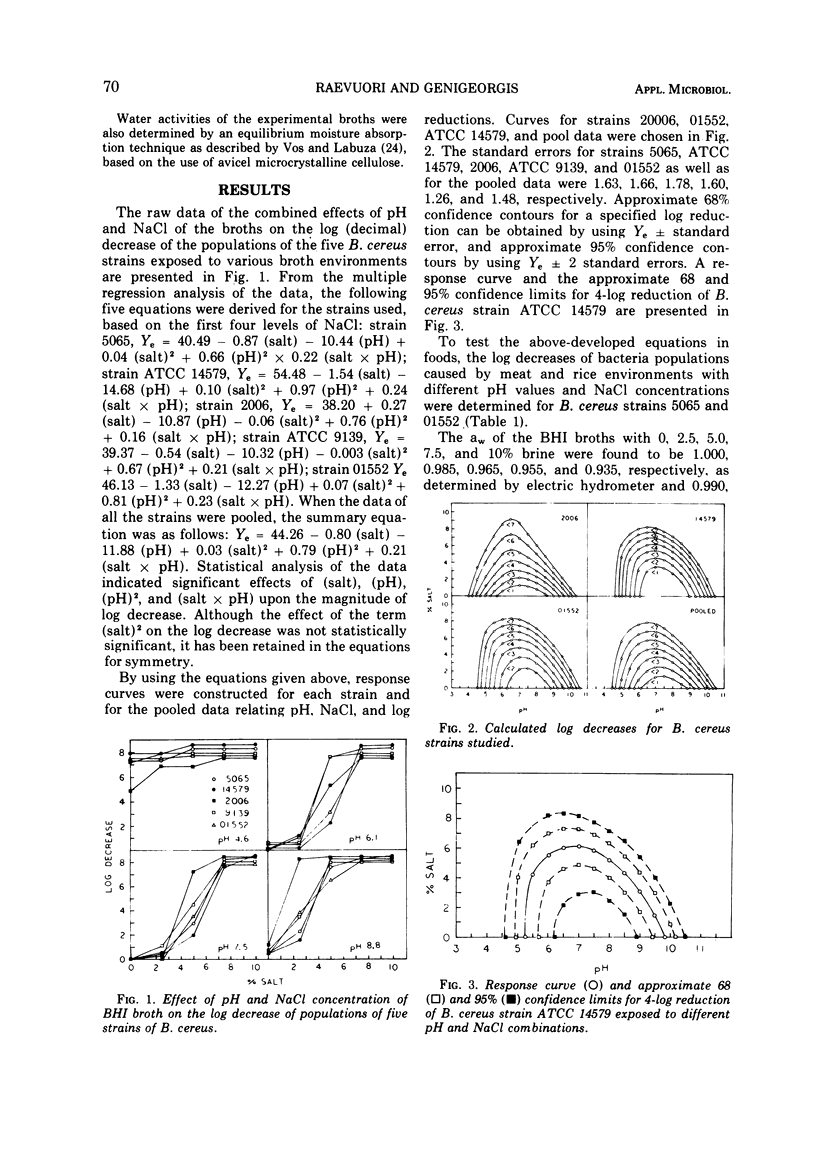Abstract
The effects of NaCl concentration, pH, and water activity (aw) on the ability of vegetative cells of Bacillus cereus to initiate aerobic growth in brain heart infusion broth at 30 C were studied in a factorial design experiment. By using multiple regression techniques, equations were derived which related the decimal reduction of the bacterial population to the concentration of NaCl and pH of broth to which the population was exposed. From these equations, the percentage of inoculated cells capable of initiating growth could be calculated. The reliability of these equations in foods was tested in laboratory-processed meat and rice media. The foods were less inhibitory than the broths, so that accurate prediction of growth initiation in foods was not possible by using the developed formulas. The impact of this type of quantitative study on the development of specific microbial standards for foods is discussed. When the NaCl concentration is increased, the aw is decreased and, with increased deviation of pH from optimum, more concentrated inoculum of B. cereus cells is needed to assure initiation of growth in culture media and foods.
Full text
PDF





Selected References
These references are in PubMed. This may not be the complete list of references from this article.
- Genigeorgis C., Martin S., Franti C. E., Riemann H. Initiation of staphylococcal growth in laboratory media. Appl Microbiol. 1971 May;21(5):934–939. doi: 10.1128/am.21.5.934-939.1971. [DOI] [PMC free article] [PubMed] [Google Scholar]
- Genigeorgis C., Savoukidis M., Martin S. Initiation of staphylococcal growth in processed meat environments. Appl Microbiol. 1971 May;21(5):940–942. doi: 10.1128/am.21.5.940-942.1971. [DOI] [PMC free article] [PubMed] [Google Scholar]
- Glatz B. A., Goeppert J. M. Extracellular factor synthesized by Bacillus cereus which evokes a dermal reaction in guinea pigs. Infect Immun. 1973 Jul;8(1):25–29. doi: 10.1128/iai.8.1.25-29.1973. [DOI] [PMC free article] [PubMed] [Google Scholar]
- Glatz B. A., Spira W. M., Goepfert J. M. Alteration of vascular permeability in rabbits by culture filtrates of Bacillus cereus and related species. Infect Immun. 1974 Aug;10(2):299–303. doi: 10.1128/iai.10.2.299-303.1974. [DOI] [PMC free article] [PubMed] [Google Scholar]
- HUNT G. A., GOUREVITCH A., LEIN J. Preservation of cultures by drying on porcelain beads. J Bacteriol. 1958 Oct;76(4):453–454. doi: 10.1128/jb.76.4.453-454.1958. [DOI] [PMC free article] [PubMed] [Google Scholar]
- Pivovarov Iu P., Kukhto A. I. Vliianie pH pishchevykh produkotov na razvitie bakterii gruppy Bac. cereus. Vopr Pitan. 1970 Jul-Aug;29(4):72–75. [PubMed] [Google Scholar]
- Prokopova L. L. Razmnozhenie i toksigennost' Bacillus cereus v pishchevykh produktakh pri razlichnykh temperaturnykh usloviiakh ikh khraneniia. Vopr Pitan. 1970 Sep-Oct;29(5):56–61. [PubMed] [Google Scholar]
- Spira W. M., Goepfert J. M. Bacillus cereus-induced fluid accumulation in rabbit ileal loops. Appl Microbiol. 1972 Sep;24(3):341–348. doi: 10.1128/am.24.3.341-348.1972. [DOI] [PMC free article] [PubMed] [Google Scholar]
- Vos P. T., Labuza T. P. Technique for measurement of water activity in the high A-W range. J Agric Food Chem. 1974 Mar-Apr;22(2):326–327. doi: 10.1021/jf60192a016. [DOI] [PubMed] [Google Scholar]


